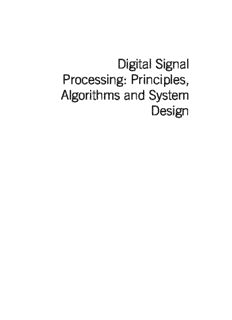Table Of ContentDigital Signal
Processing: Principles,
Algorithms and System
Design
Digital Signal
Processing: Principles,
Algorithms and System
Design
Winser E. Alexander
Cranos M. Williams
North Carolina State University
NC, USA
AMSTERDAM • BOSTON • HEIDELBERG • LONDON • NEWYORK
OXFORD • PARIS • SANDIEGO • SANFRANCISCO • SINGAPORE
SYDNEY • TOKYO
AcademicPressisanimprintofElsevier
AcademicPressisanimprintofElsevier
125LondonWall,LondonEC2Y5AS,UnitedKingdom
525BStreet,Suite1800,SanDiego,CA92101-4495,UnitedStates
50HampshireStreet,5thFloor,Cambridge,MA02139,UnitedStates
TheBoulevard,LangfordLane,Kidlington,OxfordOX51GB,UnitedKingdom
Copyright©2017ElsevierInc.Allrightsreserved.
Nopartofthispublicationmaybereproducedortransmittedinanyformorbyanymeans,electronicor
mechanical,includingphotocopying,recording,oranyinformationstorageandretrievalsystem,without
permissioninwritingfromthepublisher.Detailsonhowtoseekpermission,furtherinformationaboutthe
Publisher’spermissionspoliciesandourarrangementswithorganizationssuchastheCopyrightClearance
CenterandtheCopyrightLicensingAgency,canbefoundatourwebsite:www.elsevier.com/permissions.
ThisbookandtheindividualcontributionscontainedinitareprotectedundercopyrightbythePublisher(other
thanasmaybenotedherein).
Notices
Knowledgeandbestpracticeinthisfieldareconstantlychanging.Asnewresearchandexperiencebroadenour
understanding,changesinresearchmethods,professionalpractices,ormedicaltreatmentmaybecomenecessary.
Practitionersandresearchersmustalwaysrelyontheirownexperienceandknowledgeinevaluatingandusing
anyinformation,methods,compounds,orexperimentsdescribedherein.Inusingsuchinformationormethods
theyshouldbemindfuloftheirownsafetyandthesafetyofothers,includingpartiesforwhomtheyhavea
professionalresponsibility.
Tothefullestextentofthelaw,neitherthePublishernortheauthors,contributors,oreditors,assumeanyliability
foranyinjuryand/ordamagetopersonsorpropertyasamatterofproductsliability,negligenceorotherwise,or
fromanyuseoroperationofanymethods,products,instructions,orideascontainedinthematerialherein.
LibraryofCongressCataloging-in-PublicationData
AcatalogrecordforthisbookisavailablefromtheLibraryofCongress
BritishLibraryCataloguing-in-PublicationData
AcataloguerecordforthisbookisavailablefromtheBritishLibrary
ISBN:978-0-12-804547-3
ForinformationonallAcademicPresspublications
visitourwebsiteathttps://www.elsevier.com
Publisher:ToddGreen
AcquisitionEditor:SteveMerken
EditorialProjectManager:PeterJardim
ProductionProjectManager:MohanaNatarajan
Designer:VictoriaPearson
TypesetbyVTeX
List of Tables
Table2.1 Atabularrepresentationofadiscretetimesignal 20
Table2.2 ImpulseresponseofdiscretetimesystemforExample2.12 61
Table2.3 ImpulseresponseofFIRsysteminExample2.23 84
Table2.4 TabulationofasamplesequenceforExample2.35 118
Table2.5 TabulationofaoutputsamplesequenceforExample2.35after
interpolationusingasample-and-holdoperation 120
Table2.6 TabulationofasamplesequenceforExample2.41 136
Table2.7 TabulationofaoutputsamplesequenceforExample2.41after
decimationusingasample-and-holdoperation 137
Table3.1 TableofvaluesforX (k)forExample3.6 184
3
Table3.2 TableofvaluesforX (k)forExample3.6 184
4
Table3.3 FrequencyresponsevaluesforProblem3.1 197
Table3.4 ValuesoftheDFTforProblem3.3 198
Table3.5 TabulationofthesequenceforProblem3.9 200
Table3.6 TabulationofthesequenceforProblem3.12 201
Table3.7 FFTforsequenceforProblem3.13 202
Table4.1 FiltercoefficientsforahighpassFIRfilter 209
Table4.2 FiltercoefficientsforalowpassFIRfilter 214
Table4.3 Theimpulseresponsesforlowpassandhighpassidealfiltersfor
2M+1coefficientsshiftedbyM samples 222
Table4.4 Theimpulseresponsesforbandpassandbandstopidealfiltersfor
2M+1coefficientsshiftedbyM samples 222
Table4.5 Frequencydomaincharacteristicsforwindowfunctions[8] 223
Table4.6 Summary ofthe requiredorder forthe FIRfilters designedfor
Example4.6 238
Table4.7 Frequencytransformationsforanaloglowpassandhighpassfilters
[4] 246
Table4.8 Frequencytransformationsforanalogbandpassandbandstop
filters[4] 247
Table4.9 Digitalfrequencytransformationsforlowpassandhighpassdigital
filters[4] 249
Table4.10 Digitalfrequencytransformationsforbandpassandbandstopdigital
filters[4] 249
Table6.1 Examplesoffloatingpointrepresentationofnumbers 352
Table7.1 Comparisonofthenumberofadditionsandmultiplicationsforthe
twointerpolationmethods 411
Table7.2 Comparisonofthenumberofadditionsandmultiplicationsforthe
twodecimationmethods 417
Table7.3 Tableofcoefficientsforb6 446
Table10.1 Comparisonofcomputationalcomplexityforimplementationsofthe
2-DDFT 559
Table10.2 A2-Dsequenceasinputforthe2-DDCT 560
xiii
xiv List of Tables
Table10.3 Theextendedsequenceasinputforthe2-DDCT 560
Table10.4 The2-DDCTforthe2-Dsequence 561
List of Figures
Fig.1.1 Conceptualblockdiagramofatypicalsystem 5
Fig.1.2 StemplotforsequenceinExample1.1 10
Fig.1.3 StemplotofcosinesequenceforExample1.2 11
Fig.1.4 StemplotofadelayedimpulseforExample1.3 12
Fig.1.5 PlotofsectionofasinusoidalsignalforExample1.4 14
Fig.1.6 PlotoftherealpartofacomplexexponentialinExample1.5 15
Fig.2.1 ExampleofadiscretetimesignalasrepresentedbyTable2.1 21
Fig.2.2 Example of a discrete time signal represented by a functional
representation 21
Fig.2.3 Example of a discrete time signal represented by a sequence
representation 22
Fig.2.4 Stemplotofasequenceusingunitstepsequences 24
Fig.2.5 Stemplotofsequenceusingtheunitramp 25
Fig.2.6 Stemplotofsequenceusingexponentialsignals 26
Fig.2.7 Stemplotofsequenceusingcomplexexponentialsignals 28
Fig.2.8 Stemplotofanevendiscretetimesignal 29
Fig.2.9 Stemplotofanodddiscretetimesignal 29
Fig.2.10 Stemplotofadiscretetimesignalthatisneitherevennorodd 30
Fig.2.11 StemplotofthediscretetimesignalinFig.2.10afterflippingitleftto
righttoformx(−n) 31
Fig.2.12 Stemplotofthecomparisonoftheoriginalevensignalwiththe
extractedevensignal 31
Fig.2.13 Stemplotofthecomparisonoftheoriginaloddsignalwiththe
extractedoddsignal 32
Fig.2.14 Stemplotofasinusoidalsequence 36
Fig.2.15 Stemplotofasinusoidalsequencewithindependentvariablescaled
byafactorofa=0.5 37
Fig.2.16 Stemplotofasinusoidalsequencewithindependentvariablescaled
byafactorofa=1.5 38
Fig.2.17 Stemplotofasinusoidalsequence 39
Fig.2.18 Stemplotofasinusoidalsequencewithindependentvariableshifted
byafactorofm=6 39
Fig.2.19 Stemplotofasinusoidalsequencewithindependentvariableshifted
byafactorofm=−6 40
Fig.2.20 Stemplotofasamplesequence 41
Fig.2.21 Stemplotofthereversedsamplesequence 41
Fig.2.22 OriginaldiscretetimesignalforExample2.7 42
Fig.2.23 Transformationy1(n)=x(n−4)forExample2.7 43
Fig.2.24 Transformationy2(n)=x(3−n)forExample2.7 45
Fig.2.25 Transformationy3(n)=x(3n)forExample2.7 45
Fig.2.26 Transformationy4(n)=x(3n+1)forExample2.7 46
xv
xvi List of Figures
Fig.2.27 Transformationy5(n)=x(n)u(2−n)forExample2.7 46
Fig.2.28 Transformationy6(n)=x(n−2)δ(n−2)forExample2.7 47
Fig.2.29 Transformationy7(n)= 12x(cid:2)(n(cid:3))+ 12(−1)nx(n)forExample2.7 47
Fig.2.30 Transformationy (n)=x n forExample2.7 48
8 2
Fig.2.31 Modulation 48
Fig.2.32 Addition 48
Fig.2.33 Multiplication 49
Fig.2.34 Delay 49
Fig.2.35 Signalsx (t),x (t),andtheirsamplesonthesameplot 51
1 2
Fig.2.36 Input1forcross-correlationexample 70
Fig.2.37 Input2forcross-correlationexample 71
Fig.2.38 Blockdiagramoftheoverallsystem 71
Fig.2.39 Pole–zeroplotforExample2.25 88
Fig.2.40 Blockdiagramforadiscretetimesystem 89
Fig.2.41 RegionofconvergenceforS1(z)withb=3 95
Fig.2.42 RegionofconvergenceforS2(z)witha=0.5 95
Fig.2.43 RegionofconvergenceforX(z)witha=0.5,b=3.0 96
Fig.2.44 Stemplotofx(n)inExample2.28forn=−25ton=25 100
Fig.2.45 Comparisonofthesample-and-holdandtheideallowpassfilter 117
Fig.2.46 Reconstructionusingasample-and-holdandalowpassfilter 118
Fig.2.47 StemplotofthesamplesequenceforExample2.35 119
Fig.2.48 StemplotoftheoutputsamplesequenceforExample2.35after
usingthesample-and-holdoperation 120
Fig.2.49 Stem plot of the input and output sample sequences for
Example2.35onthesameplot 121
Fig.2.50 StemplotoftheinputandoutputsamplesequencesforExample2.35
aftercompensatingforthedelayinthesample-and-holdoperator 121
Fig.2.51 Stem plot of the input and filtered output sample sequences
for Example 2.35 after compensating for the delays in the
sample-and-holdoperatorandthefilter 122
Fig.2.52 Impulseresponseforthelinearpointconnector 122
Fig.2.53 Comparisonofthelinearpointconnectorandtheideallowpassfilter 123
Fig.2.54 Reconstructionusingalinearpointconnectorandalowpassfilter 124
Fig.2.55 SamplesequenceforExample2.36 124
Fig.2.56 Magnitude and phase responses for the sample sequence in
Example2.36 125
Fig.2.57 Magnitudeandphaseresponsesforthemodifiedsamplesequence
inExample2.36 126
Fig.2.58 SamplesequenceforExample2.36afterinterpolation 127
Fig.2.59 StemplotofsamplesequenceforExample2.37 128
Fig.2.60 Samplesequenceafterpaddingwithzeros 129
Fig.2.61 InterpolatedoutputsequenceforExample2.37 130
Fig.2.62 Abandlimitedsignalwith256samples 130
Fig.2.63 Interpolatedsignalupsampledbyafactorof3 131
Fig.2.64 Samplesequencedecimatedbyafactorof3 133
List of Figures xvii
Fig.2.65 Samplesequencedecimatedbyafactorof3usingthedecimate
Matlabfunction 133
Fig.2.66 StemplotforinterpolatedsequenceforExample2.40 136
Fig.2.67 StemplotofthesamplesequenceforExample2.41afterfiltering
usingtheantialiasinglowpassfilter 137
Fig.2.68 StemplotoftheoutputsamplesequenceforExample2.41after
usingthesample-and-holdoperation 138
Fig.2.69 Stem plot of the input and output sample sequences for
Example2.41onthesameplot 138
Fig.2.70 StemplotoftheinputandoutputsamplesequencesforExample2.41
aftercompensatingforthedelayinthesample-and-holdoperator 139
Fig.2.71 PlotofSpectrumforProblem2.28 148
Fig.2.72 PlotofspectrumforProblem2.30 148
Fig.3.1 Generaldiscretetimesystemwithinputejωn 161
Fig.3.2 MagnitudespectrumforFIRfilter 163
Fig.3.3 PhasespectrumforFIRfilter 164
Fig.3.4 MagnitudeplotofH(ω)forExample3.2 166
Fig.3.5 PhaseplotofH(ω)forExample3.2 166
Fig.3.6 Pole–zeroplotof H(z)forlowpassfilterwithcutofffrequency
ωc =0.6π 167
Fig.3.7 MagnitudeandphaseplotsofH(z)forlowpassfilterwithcutoff
frequencyωc =0.6π 168
Fig.3.8 Pole–zeroplotofH(z)forhighpassfilterwithcutofffrequency
ωc =0.6π 168
Fig.3.9 MagnitudeandphaseplotsofH(z)forhighpassfilterwithcutoff
frequencyωc =0.6π 169
Fig.3.10 Pole–zeroplotofH(z)forbandstopfilterwithcutofffrequenciesat
ω1=0.6π andω2=0.75π 170
Fig.3.11 MagnitudeandphaseplotsofH(z)forbandstopfilterwithcutoff
frequencyω1=0.6π andω2=0.75π 170
Fig.3.12 Pole–zeroplotofH(z)forbandpassfilterwithcutofffrequenciesat
ω1=0.6π andω2=0.75π 171
Fig.3.13 MagnitudeandphaseplotsofH(z)forbandpassfilterwithcutoff
frequencyω1=0.6π andω2=0.75π 172
Fig.3.14 Pole–zeroplotofH(z)fordigitalresonatorwithzerosatz = ±1,
ω=0.7π 173
Fig.3.15 Frequency response ofH(z)fordigitalresonatorwithzeros at
z=±1,ω=0.7π 174
Fig.3.16 Pole–zeroplotofH(z)fordigitalresonatorwithzerosatz = 0,
ω=0.7π 174
Fig.3.17 FrequencyresponseofH(z)fordigitalresonatorwithzerosatz=0,
ω=0.7π 175
Fig.3.18 Blockdiagramoftheoverallsystem 175
Fig.3.19 Plotof50samplesoftheinputsequenceforExample3.4 177
Fig.3.20 Plotof50samplesoftheoutputsequenceforExample3.4 178
xviii List of Figures
Fig.3.21 MagnitudeandphaseplotsforExample3.5 181
Fig.3.22 Circularconvolutionofx (n)andx (n) 183
1 2
Fig.3.23 Linearconvolutionusingconvolutioninthetimedomain 183
Fig.3.24 LinearconvolutionusingtheDFT 184
Fig.3.25 StemplotofatestsequenceforExample3.11 195
Fig.3.26 StemplotsofthemagnitudesoftheDFTandtheDCTforthetest
sequenceforExample3.11 196
Fig.4.1 Specificationsforalowpassfilter 206
Fig.4.2 StemplotforthecoefficientsinH(z)forExample4.1 210
Fig.4.3 MagnitudeandphaseplotsforH(z)forExample4.1 212
Fig.4.4 StemplotforthecoefficientsinH(z)forExample4.2 212
Fig.4.5 MagnitudeandphaseplotsforH(z)forExample4.2 214
Fig.4.6 Exampleofanideallowpassfilter(ωc =0.67π) 216
Fig.4.7 ImpulseresponseforthelowpassfilterinExample4.3 218
Fig.4.8 MagnitudeandphaseresponsesforthelowpassfilterinExample4.3 218
Fig.4.9 Exampleofanidealhighpassfilter(ωc =0.391π) 219
Fig.4.10 ImpulseresponseforthehighpassfilterinExample4.4 221
Fig.4.11 Magnitude and phase responses for the high pass filter in
Example4.4 222
Fig.4.12 ImpulseresponsesforthetwoFIRfilterdesignsusingtherectangular
windowforcomparison 226
Fig.4.13 Magnitudeandphaseresponseofbandstopfilterusingarectangular
window 227
Fig.4.14 ImpulseresponsesfortheFIRfilterdesignusingtheHamming
window 227
Fig.4.15 MagnitudeandphaseresponseofbandstopfilterusingMatlab’sfir1
functionandaHammingwindow 228
Fig.4.16 MagnituderesponsefortheFIRfilterusingtheHammingwindow 235
Fig.4.17 MagnituderesponsefortheFIRfilterusingtheKaiserwindow 236
Fig.4.18 Magnituderesponseforthedesignusingfirpm 236
Fig.4.19 DesignusingfirlsforExample4.6 237
Fig.4.20 DesignusingfirclsforExample4.6 237
Fig.4.21 Designusingfir2forExample4.6 238
Fig.4.22 Aplotofthemappingofcontinuoustimefrequenciestodiscretetime
frequenciesforthebilineartransformation 243
Fig.4.23 MagnitudeplotforExample4.13 255
Fig.4.24 MagnitudeplotforExample4.14 256
Fig.5.1 BlockdiagramforthedirectrealizationofanFIRdiscretetime
system 278
Fig.5.2 BlockdiagramforthedirectimplementationofanFIRdigitalfilter 279
Fig.5.3 BlockdiagramforalinearphaseFIRdigitalfilter 281
Fig.5.4 BlockdiagramforalinearphaseFIRdigitalfilter 282
Fig.5.5 PolyphaseFIRimplementationusing2filters 285
Fig.5.6 PolyphaseFIRimplementationusing3filters 287
Fig.5.7 FIRlatticefiltersection 288
Description:Digital signal processing (DSP) has been applied to a very wide range of applications. This includes voice processing, image processing, digital communications, the transfer of data over the internet, image and data compression, etc. Engineers who develop DSP applications today, and in the future, w

